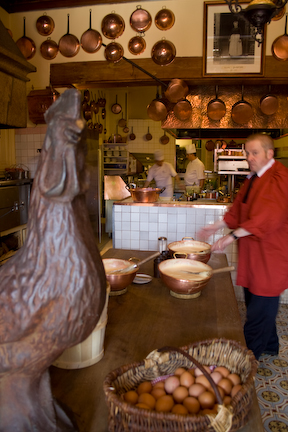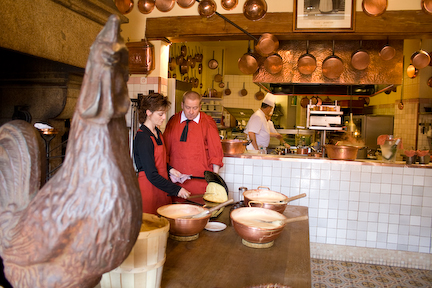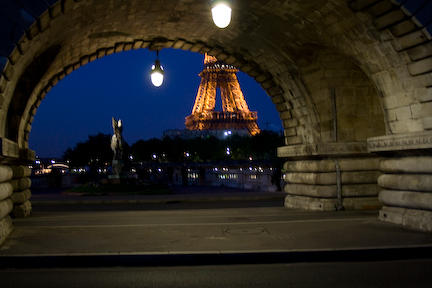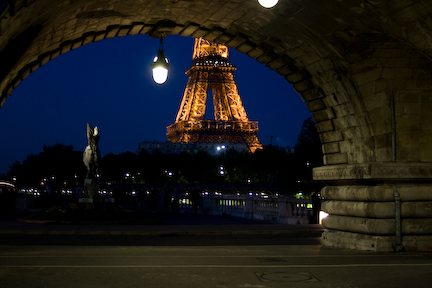Last week’s photography expedition in Paris, France, did NOT start well for me. On Day One, I accidentally left my camera bag unzipped and when I picked it up off the floor, my camera rolled out. It wasn’t a hard roll but it must have hit the ground just right because it broke my lens. Now the lens won’t focus. Fortunately, professional photographer, Rich Wagner, looked at it. He says it’s fixable. I can send it to Canon and (for a fee) they’ll fix it and send it back. However, I was still in Paris (on a photo workshop, mind you) with a camera that was useless without a lens. So I started to look for a new one. Rich recommended I get a “fast” lens. Fast lenses are great for portraits and for photographing things in low light. (Learn more tips from Rich and many other professional photographers at one of our live events. Click here to see our Workshop Schedule.) Here’s what that means… Lenses are generally classified by their focal length and their maximum aperture. A 28-135mm f3.5-5.6 zoom lens like the one I broke has a lens focal length between 28 and 135 mm and a maximum aperture of f.3.5 – f5.6 depending on how far I extend the telephoto (zoom). Aperture, if you don’t know, is like the iris of your eye. The more you open up your aperture, the more light you let into your camera. And conversely, the more you close it, the less light you let in. And aperture is measured in f-stops. F-1.0 is the widest aperture setting you can get — the most light your lens can let in. And f-22 is the smallest — the least amount of light you can let in. So on my camera, with my 28-135 mm f3.5- f5.6 lens (the one that’s broken), I can’t open it up all the way. I can only open it to f3.5. That’s the maximum aperture for that lens. So what does “fast” mean? Fast, when talking about a lens, actually refers to the greatest amount of light the lens will let in. Think of it this way… If your camera needs more light to hit the digital sensor in order to make a correctly exposed image, then it has three choices: ** 1) It can open up your aperture and let more light in through the lens… ** 2) It can slow down your shutter speed and let the light that’s coming in from your lens sit on the digital sensor for a longer amount of time… ** 3) It can speed up the “film speed” or ISO on digital cameras. So if your camera measures the light in the room and thinks it needs an aperture reading of 1.4 but your lens only opens to 5.6, it’ll slow your shutter speed to get the shot. And a slow shutter speed — if you’re hand holding your camera — will give you a blurry image. Most photographers consider a fast lens to be one that will open up to at least f-2.8. That’s a lot more light than what I can get with my (broken) f3.5 lens. (Remember, 1.0 is the largest aperture setting you can get. So 2.8 will open up a lot more than 3.5 — the smaller the f-stop number, the larger the opening on the lens.) And an even faster lens would be one that can open up to f-1.4. (To get f-1.4, though, you’d have to give up the zoom feature and use a “fixed focal length” lens. You won’t be able to zoom but a lens like that would let you hand hold the camera even in a dim restaurant. So Rich recommended I get a 24-70mm 2.8 lens. That’s a lens with range from moderate wide angle to moderate telephoto (great for street shooting in Paris) and a larger maximum aperture (the f-stop, or the 2.8 number) for shooting in dim restaurants and cafes. Now, is that “fast” lens an absolute necessity for getting great shots in a restaurant or café? No, not necessarily. Something faster than what I already have would be a nice addition to my toolkit for portraits and shooting indoors. But I don’t “need” it. Here, for example, are a few other ways you can get better shots in low-light — without buying a faster lens… ** 1. Use a tripod, which would allow you to take the picture with a slow shutter speed without worrying too much about camera shake. (If you don’t have a tripod, you can try bracing my camera against something sturdy like a table, wall, or light post.) ** 2. Experiment with different ISO settings that will allow light to sit on the digital sensor longer without slowing the shutter speed. Here are a few pictures to show you the difference… This was a grab shot in a restaurant on Mont St. Michel with ISO 100. I was hand-holding the camera (no tripod): 



Travel Photography Resources
5 Dos and 2 Don’ts for Travel Photography
Take Great Photos And Get Paid More For Your Travel Articles
Turning a Photography Hobby into a Monthly Income
The Pros Of Selling Your Images As Stock Photography
16 Mobile Photography Tips And Tricks Every Photographer Should Know

